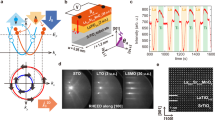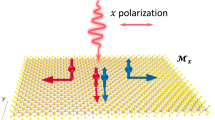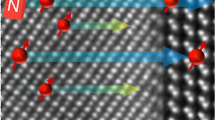Abstract
A fundamental prerequisite for the implementation of organic semiconductors (OSCs) in spintronics devices is the still missing basic knowledge about spin injection and transport in OSCs. Here, we consider a model system consisting of a high-quality interface between the ferromagnet cobalt and the OSC copper phthalocyanine (CuPc). We focus on interfacial effects on spin injection and on the spin transport properties of CuPc. Using spin-resolved two-photon photoemission, we have measured directly and in situ the efficiency of spin injection at the cobalt–CuPc interface. We report a spin injection efficiency of 85–90% for injection into unoccupied molecular orbitals of CuPc. Moreover, we estimate an electron inelastic mean free path in CuPc in the range of 1 nm and a 10–30 times higher quasi-elastic spin-flip length. We demonstrate that quasi-elastic spin-flip processes with energy loss ⩽200 meV are the dominant microscopic mechanism limiting the spin diffusion length in CuPc.
This is a preview of subscription content, access via your institution
Access options
Subscribe to this journal
Receive 12 print issues and online access
$259.00 per year
only $21.58 per issue
Buy this article
- Purchase on Springer Link
- Instant access to full article PDF
Prices may be subject to local taxes which are calculated during checkout





Similar content being viewed by others
References
Forrest, S. R. The path to ubiquitous and low-cost organic electronic appliances on plastic. Nature 428, 911–918 (2004).
Wolf, S. A. et al. Spintronics: A spin-based electronics vision for the future. Science 294, 1488–1495 (2001).
Pramanik, S. et al. Observation of extremely long spin relaxation times in an organic nanowire spin valve. Nature Nanotech. 2, 216–219 (2007).
Dediu, V., Murgia, M., Matacotta, F. C., Taliani, C. & Barbanera, S. Room temperature spin polarized injection in organic semiconductor. Solid State Commun. 122, 181–184 (2002).
Xiong, Z. H., Wu, D., Valy Vardeny, Z. & Shi, J. Giant magnetoresistance in organic spin-valves. Nature 427, 821–824 (2004).
Sanvito, S. Spintronics goes plastic. Nature Mater. 6, 803–804 (2007).
Salis, G., Alvarado, S. F., Tschudy, M., Brunschwiler, T. & Allenspachet, R. Hysteretic electroluminescence in organic light-emitting diodes for spin injection. Phys. Rev. B 70, 085203 (2004).
Jiang, J. S., Pearson, J. E. & Bader, S. D. Absence of spin transport in the organic semiconductor Alq3 . Phys. Rev. B 77, 035303 (2008).
Zhan, Y. Q. et al. Energy level alignment and chemical interaction at Alq3/Co interfaces for organic spintronic devices. Phys. Rev. B 78, 045208 (2008).
Andreyev, O. et al. Spin-resolved two-photon photoemission study of the surface resonance state on Co/Cu(001). Phys. Rev. B 74, 195416 (2006).
Tanaka, A., Yan, L., Neil, J. W. & Gao, Y. Femtosecond time-resolved two-photon photoemission study of organic semiconductor copper phthalocyanine film. J. Electron Spectrosc. Relat. Phenom. 144–147, 327–329 (2005).
Ellis, T. S., Park, K. T., Hulbert, S. L., Ulrich, M. D. & Rowe, J. E. Influence of substrate temperature on epitaxial copper phthalocyanines studied by photoemission spectroscopy. J. Appl. Phys. 95, 982–988 (2004).
Johnson, P. B. & Christy, R. W. Optical constants of transition metals: Ti, V, Cr, Mn, Fe, Co, Ni, and Pd. Phys. Rev. B 9, 5056–5070 (1974).
Djurišić, A. B. et al. Optical properties of copper phthalocyanine. Opt. Commun. 205, 155–162 (2002).
Acknowledgements
This work was supported in part by the NSF under Grant No. DMR-0602870 and by DFG Research Grant No. AE 19/8-2.
Author information
Authors and Affiliations
Corresponding author
Supplementary information
Supplementary Information
Supplementary Information (PDF 632 kb)
Rights and permissions
About this article
Cite this article
Cinchetti, M., Heimer, K., Wüstenberg, JP. et al. Determination of spin injection and transport in a ferromagnet/organic semiconductor heterojunction by two-photon photoemission. Nature Mater 8, 115–119 (2009). https://doi.org/10.1038/nmat2334
Received:
Accepted:
Published:
Issue Date:
DOI: https://doi.org/10.1038/nmat2334
This article is cited by
-
Molecular design for enhanced spin transport in molecular semiconductors
Nano Research (2023)
-
Effect of Electron and Hole Injection on Spin Polarization in Bis-(8-hydroxyquinoline) Zinc Molecule
Journal of Superconductivity and Novel Magnetism (2022)
-
Complete polarization of electronic spins in OLEDs
Nature Communications (2021)
-
Ultrafast terahertz magnetometry
Nature Communications (2020)
-
Achieving large and nonvolatile tunable magnetoresistance in organic spin valves using electronic phase separated manganites
Nature Communications (2019)



